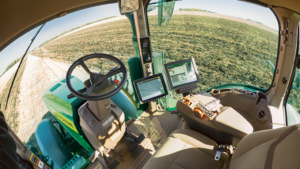Farm debt management
CONVERSATIONS WITH BUSINESS EXPERTS

(J.M.) WHAT DO RISING INTEREST RATES MEAN FOR FARM DEBT IN CANADA?
(C.K.) Until recently, interest rates had declined since the late 1980s and early 1990s. So, most Canadian farmers in business today have been enjoying those declining interest rates for much of their careers. This new financial environment is an adjustment and calls for some conversations farmers have never had to have.
Over the years, farmers have taken advantage of the declining rates, taking on more short- and long-term debt to invest in and grow their operations. While this has been great for business, it means that today, financial management is more important than ever. Unfortunately, agriculture is a price taker for everything — from interest rates to inputs and even our end products. It’s also important to note that every sector across Canada is feeling the pinch of a high-cost environment – from rising interest rates to soaring input costs for crops and feed.
It’s not all bad news, though. Rising interest rates come with opportunities too. A renewed focus on finances and debt management means farmers may become more efficient out of necessity.
WHAT ADVICE CAN YOU OFFER GRAIN FARMERS CONCERNED ABOUT MANAGING THEIR DEBT LOAD?
Be prepared to have conversations with your lender. And start early — if you’re concerned, book a meeting with your lender before any renewal dates or your annual review. The more time you have to plan, the more opportunities you have to take advantage of fluctuating rates, payment structures, or changes to your financial or management plan. My best advice is to make sure you have a plan that allows you to sleep at night.
Keep your financials up to date and understand your farm’s financial health. Know where you need to find improvements and efficiencies. Try challenging yourself and your farm advisory team to find opportunities and ways to economize.
Maintain a farm business plan and strategy. No matter the financial environment, you still need a plan and a vision with goals. While some of your aspirations may need to be put on hold due to the current financial environment, keeping your risk management strategy and future plans in mind can also help identify opportunities or manage realistic timelines. Be willing to adjust your vision to weather rising interest rates and input costs.
Relationships are important. Surround yourself with a trusted farm advisory team and talk to them. Consult your team to make smart business decisions so you can take advantage of any opportunities.
Find the right payment strategy. Everyone has different comfort levels and tolerance when managing debt loads and repayment schedules. Work closely with your lender, and be prepared to have frank conversations about interest rate strategies. Fixed rates are beneficial for those who prefer the security of knowing what their payment is and the income needed to make those payments. If security helps you sleep at night, locking in a fixed rate might be your best option. Variable interest rates mean less certainty, especially in today’s environment. Some are more comfortable with a variable option because they can leverage fluctuating market movements. A combination of fixed and variable rates can be a good solution, especially if you are managing short- and long-term debt. Again, consult your lender to discuss options to find the best fit for your farm financials.
HOW DO YOU PLAN FOR THE FUTURE IN A RISING INTEREST RATE ENVIRONMENT?
Agriculture is adaptive, and farmers are business savvy. The current financial environment does not restrict farmers from making future business plans. The key is to have a vision, create a risk management strategy (that includes managing rising interest rates), and identifying what success looks like for you, your farm and your family. And then be willing to adjust to those expectations.
Now may not be the best time for significant financial investments in your operation, given the uncertainty of input and lending costs. But if you have a plan, it can help you identify and evaluate opportunities as they arise.
Every farmer is in a position to make smart decisions today to weather the current financial environment and invest in the future of their farm businesses. •



















